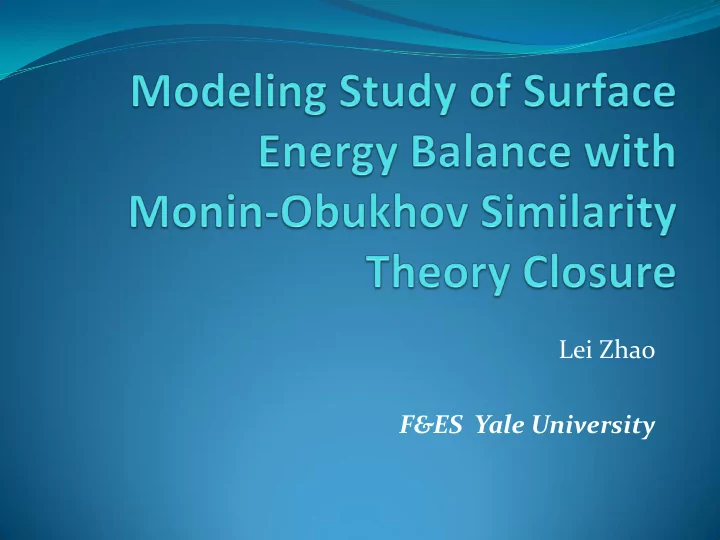

Lei Zhao F&ES Yale University
Outline Basic Idea Algorithm Results: modeling vs. observation Discussion
Basic Idea Surface Energy Balance Equation Diagnostic form: Heat capacity of ground — zero ; ground heat flux – zero; the terms in SEB are either computed separately or parameterized in terms of Ts, so that the equation is solved iteratively Non-rate equation for Ts
Basic Idea Through parameterization, SEB contains Ts as an only unknown variable Known variables: incoming Solar radiation, albedo, incoming longwave radiation, wind speed
Algorithm Net radiation – defined as: All the terms in the SEB are either specified from the dataset or parameterized in terms of Ts: 4 S ( 1 a ) L T ( 1 ) L c ( T T ) / r ( q * q ) /( r r ) d d s d p s a a s a
Algorithm Given specified L d , a, S d , the resistance needs to be parameterized in terms of Ts so as to close the whole system Theoretically, one can solve the SEB for surface temperature Ts , since Ts is the only unknown variable in the system Nonlinear system, thus Newton’s method applied
Algorithm – Monin-Obukhov Parameterization The resistance parameterization scheme should involve the surface temperature Ts as the only unknown variable Big-leaf model: Aerodynamic resistance Stoma resistance At this stage, only incorporate the subroutine of aerodynamic resistance by leaving the stoma resistance as a constant
Algorithm – Monin-Obukhov Parameterization Based on Monin-Obukhov similarity theory, different models proposed According to Liu et al(2006), Choudhury (1986), Thom(1975), Xie Xianqun(1988) model showed better agreement Thom and Xie ’ model applied in this study
Algorithm – Monin-Obukhov Parameterization Thom model z d z d z d z d 1 r * ln( ) ( ) ln( ) ( ) 2 a m h k U z L z L z 0 T In neutral condition, 0 m h 2 1 x 1 x In unstable condition, 2 ln( ) ln( ) 2 arctan( x ) / 2 m 2 2 In stable condition, 5 m h z d where, L 1 / 4 x ( 1 16 )
Algorithm – Thom model How to evaluate L : L is a funtion of u* and Ts u* can be calculated from C D Therefore, all the quantities are looped tegother:
Algorithm – Thom model Loop: C D C D, u* C H ψ ( ξ ) L ξ
Algorithm – Thom model Convergence problem: A good initial guess is required for convergence How to get a close guess for C D C DN (neutral condition) is introduced to trigger the loop C DN is only dependent on z-d and z 0
Algorithm – Thom model Convergence problem: still encounter unconvergence Examine the shape of drag coefficient
Algorithm – Thom model Figure 1 Relation of Drag coefficient C D vs. Stability correction function ψ
Algorithm – Thom model Therefore, some thresholds for are needed As widely used in the literatures, is cut in the interval between -5 and 1
Algorithm – Monin-Obukhov Parameterization Xie ’ model h r r 1 a aa z d ln( ) z 0 z d z d ln( ) ln( ) r aa is the aerodynamic resistance in neutral condition, z z 0 T r aa 2 k U z In neutral condition, =0 h In unstable condition, 1 / 2 0 . 03 ( 1 16 ) h In stable condition, 1 n 0 0 . 03 0 h where, n is empirical coefficient, when , n=5.2; when , n=4.5 0 0
Algorithm – Model structure Newton’s method is the main iteration for solving Ts In each iteration, new computed Ts goes to the resistance loop for resistance calculation The resistance return to the main iteration for calculating a newer Ts
Input data Driven by: the measurements of incoming solar radiation, surface albedo, incoming longwave radiation, and wind velocity at a certain height Data used: Old aspen site 2000 Jan.
Results Comparison between the modeling results and the observations: Surface Temperature – Ts Sensible Heat Flux – H Latent Heat Flux – λ E
Results - Surface temperature Thom model
Results - Surface temperature Thom model
Results - Surface temperature Xie model
Results - Surface temperature Xie model
Results – sensible heat flux Thom model
Results – sensible heat flux Xie model
Results – latent heat flux Thom model
Results – latent heat flux Xie model
Discussion Why the heat flux modeling results are bad: r s is set as a constant Soil heat flux G is not taken into account Real temperature vs. Potential temperature Reliability of the turbulent flux measurement Need your ideas
Discussion Tuning value of r s by examining the error of Ts
Discussion Diagnostic form heat capacity of the canopy is assumed as zero Not take into account the canopy heat flux G
Discussion Temperature using real temperature, rather than potential temperature, since only have the pressure measurement at one level
Discussion Reliability of the turbulent flux measurement
Discussion NARR prediction
Discussion NARR prediction
Discussion NARR prediction
Discussion NARR prediction
Discussion NARR prediction
Lei Zhao F&ES Yale University
Results - Surface temperature
Results - Surface temperature
Results – sensible heat flux Thom model
Results – sensible heat flux Thom model
Results – latent heat flux Thom model
Results – latent heat flux Thom model
Observation Check with NARR
Observation Check with NARR
Observation Check with NARR
Lei Zhao F&ES Yale University
Canopy Resistance
Canopy Resistance Canopy resistance shows a strong response to PAR, LAI, saturation deficit, air temperature and soil water content. The paper discussed the diurnal dynamic response to PAR and saturation deficit Also seasonal dynamics of canopy resistance, mainly dependent on forest LAI
Canopy Resistance
Canopy Resistance Simple method in the subroutine: Parameterize it as a function of PAR and saturation deficit Different PAR corresponds to different g_max Exponentially decay on increasing saturation deficit
Canopy Resistance
Canopy Resistance
Canopy Resistance
Canopy Resistance
Recommend
More recommend